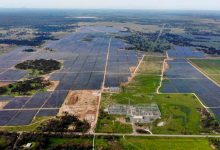Solar and wind projects in both south -west NSW and north west Victoria face further constraints on their output after the NSW-based transmission company Transgrid warned of a potential voltage collapse in yet another part of the grid that it operates.
A market notice published by the Australian Enegy Market Operator on Thursday flagged a new constraint that will affect solar and wind projects in what is known as the West Murray region of the grid, already a centre of multiple problems that have emerged over the last two years.
The new notice follows an earlier warning in August that the growing number of solar and wind projects in south-west NSW faced “significant” cutbacks because of growing congestion in the grid west of Wagga Wagga.
The new warning affects the line beyond Darlington towards Balranald, and follows new modelling that has detected the risk of “voltage collapse” should one of the other major transmission lines in the region trip. Because this is an ongoing risk, the new constraint – which came into effect on Friday morning – will be categorised as “system normal”, meaning that it will be applied regularly.
Solar and wind projects in the area have already suffered deeply because of network issues. Five solar farms in Victoria and NSW had their output cut in half for more than seven months from last September to mid April because of the fear of “voltage oscillations” that was only resolved with updates to the inverter technology.
As a result, new connections were delayed, with up to two dozen different projects held back – some even after they had been built – as the commissioning process was turned into a lengthy queue dubbed “sequencing”.
In May, Transgrid issued the first warning to new and existing projects in the south-west of the state, and more recently AEMO effectively put up the “house full” sign for the area, saying there was effectively no place for new projects without further significant investment in network infrastructure.
RenewEconomy understands that the new modelling conducted by Transgrid shows that at times of high (wind and solar) generation in south-west NSW and north-west Victoria, the loss of a transmission line in north-west Victoria would result in very high power flows through 220 kV transmission lines from Buronga via Balranald to Darlington Point.
These flows could in turn result in severe under-voltage conditions and voltage collapse at Balranald. The immediate solution is to limit the power flow in an easterly direction on the 220 kV transmission line from Balranald to Darlington Point, to ensure the power system remains within stable and safe limits.

RenewEconomy understands that power flows to date have not been sufficiently high to reach the limit yet, but they will be when new generators are commissioned over the next few months – including some of the state’s biggest solar farms at Sunraysia and Limondale, and power flows increase.
The WattClarity web site suggested that wind and solar farms in the north-west of Victoria, including those in the area dubbed the “rhombus of regret” may also be impacted.
Some improvements may be possible through the fine tuning of generator control systems, although this require a collaborative effort by AEMO, network service providers, generation developers and original equipment manufacturers.
However, the constraint is unlikely to be alleviated until the proposed new transmission link between South Australia and NSW, the $2.4 billion Project EnergyConnect, is approved by the Australian Energy Regulator, and built as planned by 2024/25.
The NSW government has identified the south-west of NSW as a site of one of its three planned renewable energy zones, as this map of renewable energy resources prepared by Transgrid illustrates.
But the NSW government focus appears to be on the central west and New England zones, and now in the Hunter region as it seeks multi-party support for its plans to transition the state’s grid from coal to renewables.
The south-wests region, however, hosts some of the best solar resources in the state, and some good wind resources, and the latest constraint advice is yet another blow to developers who have faced delays, cutbacks and significant losses – and this comes despite some projects installing costly synchronous condensers to their project in an effort to dodge any problems.











